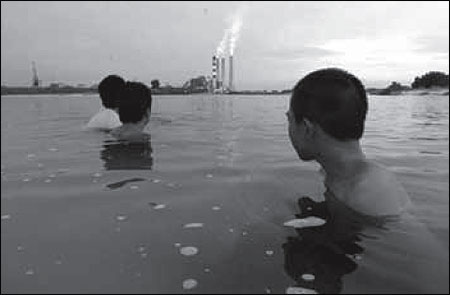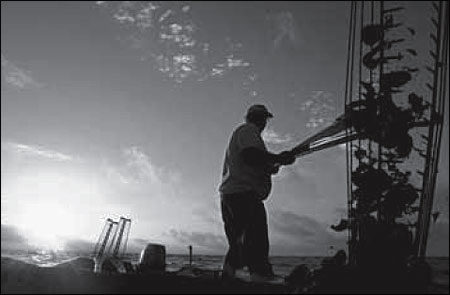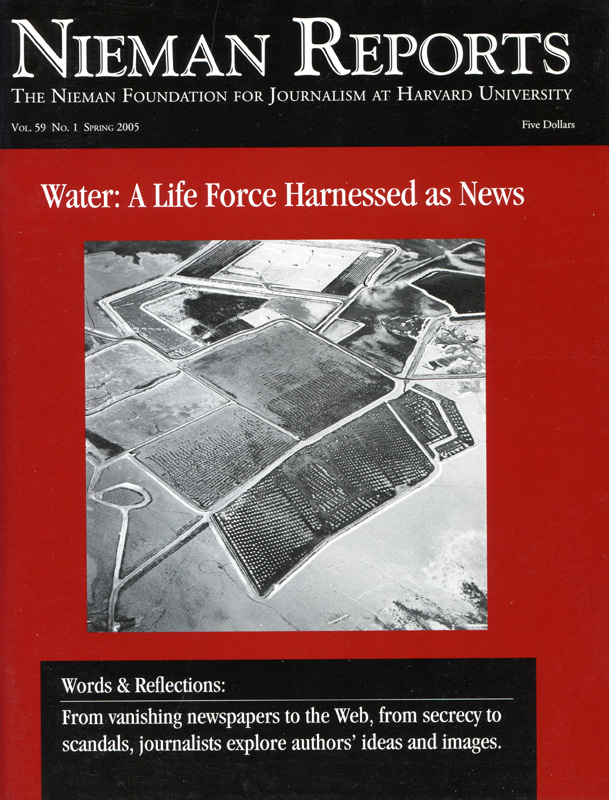
Children swim in the waters warmed by the discharge from the Tampa Electric company’s Big Ben Power Plant. Photo by David Ahntholz/Naples Daily News.
A river-rafting metaphor might best describe the experiences of Naples (Fla.) Daily News writers and photographers who set out to document threats to the Gulf of Mexico. No one making this journey was ever exactly sure what was around the next corner, but they were certain the story they’d emerge with would be worth getting a little wet along the way.
In the spring of 2002, fishermen returning to port spoke of being amazed at the unusual sight of a mass of black water in the Gulf of Mexico between Naples and the Florida Keys. They described it, aptly, as a dead zone.
What started out in our newsroom as a search for answers about why and how this black water got into the gulf ended 18 months later when the Naples Daily News published 15 consecutive special sections in a series called “Deep Trouble: The Gulf in Peril.” The series explained to readers how coastal population growth and industry are destroying wetlands, polluting rivers, injuring marine life, and sickening people. It also described how laws meant to stop this decline are failing. Working on this series proved to us that even small newspapers—if given an unwavering commitment of time and money—can make a positive difference in the lives of their readers.

An oysterman tongs out oysters in Mobile Bay, Alabama, where its reefs are blanketed with sediment from sewage runoff. Photo by Romain Blanquart/Naples Daily News.

Jo Ann Allen received radiation treatment for cancer at a Pensacola, Florida hospital. She suspected that her health problems were related to dioxin or other harmful chemicals in a paper mill’s discharge, though it hasn’t been proven this caused her condition. Photo by Romain Blanquart/Naples Daily News.
Working the Story
Work on this collection of stories involved eight reporters and five photographers based in southwest Florida and correspondents in Tallahassee and Washington, D.C.. To make this work possible required a newsroom-wide shift both in how people were deployed and how they came to think about their work. Members of the team took weekly turns immersing themselves in “Deep Trouble.” As target publication dates drew nearer, editors took some reporters off their beats indefinitely. That meant still other reporters filled in on must-cover stories or did double duty on their beats. Editors sometimes had to make difficult decisions about what to cover and what to sacrifice because of ongoing work on the series. And reporters, accustomed to rooting out news every day and getting it into the paper, had to take a more long-term view of their jobs.
Hard and fast publication dates were avoided. The mantra was to get it done right—not just get it done. Soon after the Daily News began publishing news stories about what it dubbed black water in the Gulf of Mexico, editors and reporters sat around a conference table and strategized about how to advance our reporting. They divided the Gulf Coast from Mexico around to Florida into sections, including coastal counties and parishes. Reporters consulted everything from scientific journals to travel guides to find out everything they could about their assigned stretch of the coast—its population trends, its history and physical features, and also its environmental watchdogs and its biggest polluters.
After months of reporting from their desks, teams of reporters and photographers visited each region to see for themselves what they had been told about over the telephone. Not surprisingly, in these earlier phases Google became many reporters’ best friend. A well thought-out Internet search often unleashed waves of good information and good leads for where to go next. Taking the time to wade through seemingly useless Web links often paid big dividends, as did making friends with disgruntled state and federal Environmental Protection Agency (EPA) officials, who can lead the way to the larger story and are freer with the truth than most current officials. In reporting a story like this one, the ability to find honest environmental officials lends balance to what the agency’s spokespeople say and the criticisms heard from environmentalists.
Journalists who routinely cover water issues are trained to sniff out when polluters break the law. But it is just as important, if not more crucial, to focus on how much polluting is being done legally. And what might be illegal today might be legal tomorrow. For example, a paper mill can dump chemicals such as formaldehyde, ammonia and chloroform into the Mississippi River—as one in Natchez, Mississippi did for decades—and do so with permission of the EPA as long as the plant’s emissions don’t exceed the agency’s guidelines. While federal officials will claim their guidelines offer environmental protection, irate neighbors and environmentalists contend this isn’t so.
This debate—emblematic of the many nuances of environment reporting— is one we encountered often in researching this series. Not everything is black and white, nor do the words legal and illegal do justice to these issues.
While this series about the gulf ’s water was essentially an environment beat story, its telling benefitted enormously from having reporters from several other beats join in our coverage. For example, one city desk reporter’s experience in crunching census data allowed the series to draw a parallel between what was occurring in coastal growth and pollution. The series also illustrated to us the importance of having a diverse newsroom. Having a reporter and a photographer who could speak Spanish enabled the series to report internationally with an investigation of environmental conditions along the Gulf Coast of Mexico.
As our team of reporters gathered information, themes emerged, and a strategy developed for bringing the project to readers. About half of the special sections would be devoted to reports on gulf-wide topics, not all of them obviously environmental. Some of these topics included overfishing, tourism, industrial pollution, human health, and failing environmental regulation. Other stories were geographically driven, and these helped readers make connections between the health of the Gulf of Mexico and the people who live in communities along its long edge.
Our reporting on the black water phenomenon uncovered gaps in monitoring programs and explored divergent opinions about black water’s cause. By the time the research arm of the Florida Fish and Wildlife Conservation Commission could arrange to sample the black water, it had largely dissipated. Few clues remained about what had caused it to appear. Scientists believe that the black water was made up mostly of a bloom of nontoxic microscopic organisms called diatoms that were fed by a slug of nutrients from a decaying toxic algae bloom and runoff from the Everglades. When black water showed up again in 2003, satellite pictures showed a connection with runoff from the Caloosahatchee River.
These black water events have touched off politicized debates about whether out-of-control coastal growth or agricultural practices should shoulder the blame. Many experts contend the problem is related to both.
Water can be a dry topic full of jargon: sediment contamination, storm water runoff, 303(d) lists, and Section 404 permits. The human stories—the characters and what they endure as a result of these circumstances—are what bring these issues home to readers. There was the story we shared of Jo Ann Allen, a Florida panhandle woman who traced her cancer to toxins in which she was cloaked for a half century as a nearby paper mill spit them into the Gulf of Mexico’s Perdido Bay. Illuminating her struggle with this disease was as important as telling the story of the back-and-forth arguments between Alabama and the paper mill to clean up the mill’s discharges.
Each special section featured a collection of “Profiles on the Gulf,” and these featured snippets of wisdom from people we’d met during our reporting. The net for these profiles was cast wide to include Chamber of Commerce leaders, wildlife rescuers, scientists, neighborhood activists, fishermen, mayors, kayakers, and old-timers. Listening to them kept our reporting grounded and reminded us, time and again, how much people care what is happening with the water around them.
Journalists should, too.
Eric Staats is the environment reporter for the Naples Daily News. Jeremy Cox, city government reporter, and Janine Zeitlin, projects reporter, contributed to the writing of this article. “Deep Trouble: The Gulf in Peril” won the Edward J. Meeman Award for environmental reporting (under 100,000 circulation) and second place for in-depth reporting from the Society of Environmental Journalists. The reporters on the series were Cathy Zollo, Alan Scher Zagier, Chad Gillis, Dianna Smith, Gina Edwards, Zeitlin, Cox and Staats, and the correspondents were Michael Peltier and Jennifer Sergent. The photographers were Romain Blanquart, Gary Coronado, Cameron Gillie, David Ahntholz and Dan Wagner. To read the series, go to www.naplesnews.com.



